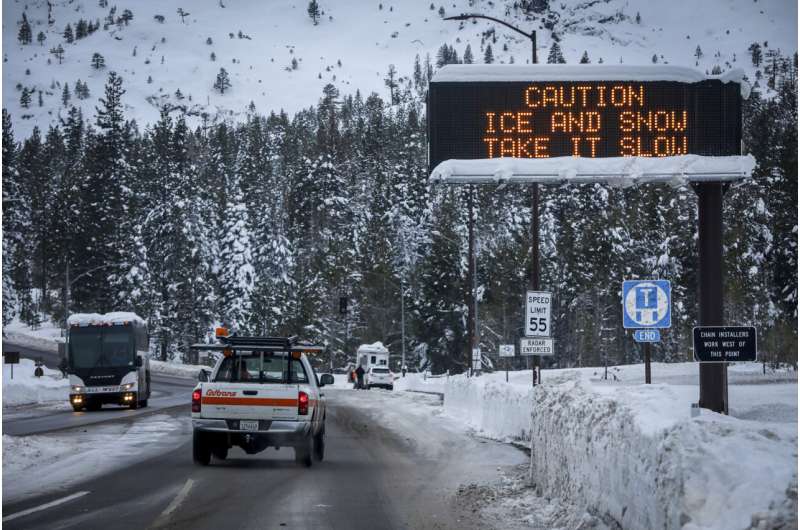This article has been reviewed according to Science X's editorial process and policies. Editors have highlighted the following attributes while ensuring the content's credibility:
fact-checked
reputable news agency
proofread
California eases water restrictions, but drought isn't over

California Gov. Gavin Newsom ended some of the state's water restrictions on Friday because a winter of relentless rain and snow has replenished the state's reservoirs and eased fears of a shortage after three years of severe drought.
Newsom was careful not to declare the drought to be over, noting water shortages remain in the Klamath River basin along the California-Oregon line and in densely populated Southern California, which relies heavily on the struggling Colorado River system to supply millions of people.
But Newsom did say he would stop asking people to voluntarily cut their water use by 15%, a request he first made nearly two years ago while standing at the edge of a nearly dry Lopez Lake in the state's Central Coast region—a lake that today is so full from recent storms it is almost spilling over.
"None of us could have imagined ... a few months ago that we'd be where we are today," Newsom said Friday from a farm northwest of Sacramento that has flooded some of its fields with excess water so it will seep underground and refill groundwater basins. "Are we out of the drought? Mostly—but not completely."
Newsom's call for voluntary conservation had mixed results. Californians did reduce their water use, but only by 6.2% overall, according to data from the State Water Resources Control Board. Newsom never ordered statewide, mandatory water restrictions—but he did require water agencies to impose some limits on their customers.
Friday, Newsom said he was easing those rules. That change will impact people in different ways depending on where they live. For most people, it means they won't be limited to watering their lawns on only certain days of the week or at certain times of the day. Other restrictions will remain in place indefinitely, including a ban on watering decorative grass for businesses.

"We've got to conserve as a way of life," Newsom said.
Newsom could ease some restrictions in part because California's reservoirs are now so full that cities will get more than double the amount of drinking water this year compared to a previous allocation announced last month. Now, water districts that serve 27 million people will get at least 75% of the water they requested from state supplies. Last year, they only got 5% as California endured three of the driest years ever since modern recordkeeping began in 1896.
"This wet winter, which has led to a large increase in our (water) allocation, is not a signal that we can relax," said Adel Hagekhalil, general manager of the Metropolitan Water District of Southern California that supplies water to 19 million people. "It is an alarm to act and accelerate our efforts to respond to rapidly changing conditions, including conservation, storage, recycling and reuse."
Last week the district ended mandatory drought restrictions for about 7 million people who rely almost exclusively on state supplies for their water.
California and the western United States have been in an extended drought for about two decades, a period of abnormal dryness punctuated by occasional intense seasons of storms. It would be tough for a governor "of a large, diverse state that has very diverse water supplies and water demands" to say when a drought has started or ended, said Jay Lund, vice director for the Center for Watershed Sciences at the University of California, Davis.
Lund said the drought is over from many perspectives in California, including urban water supply and reservoirs. But it's not over for the state's fragile ecosystems and the groundwater aquifers that were depleted during recent drought years.

"We might never recover them completely," he said.
Three years of little rain or snow in California had depleted reservoirs to the point the state couldn't generate electricity from hydroelectric power plants. It dried up wells in rural areas and state officials had to truck in water supplies for some communities. And it reduced the flow of the state's major rivers and streams, killing off endangered fish and other species.
But since December, no less than 12 powerful storms have hit California, packing so much rain and snow that meteorologists call them "atmospheric rivers." These storms have flooded homes, closed ski resorts and trapped people in mountain communities for days with no electricity, prompting emergency declarations from President Joe Biden.
"That kind of whiplash is something that we've experienced in a very intense way in California that I think is unique across the western U.S.," said Karla Nemeth, director of the California Department of Water Resources.
Water has been steadily pouring into the state's reservoirs since December. Of California's 17 major reservoirs, 12 of them are either at or above their historical averages for this time of year.
And more water is coming. Statewide, the amount of snow piled up in the mountains is already 223% above the April 1 average—the date when the snowpack is typically at its peak. Most of that snow will melt in the coming months, flowing into reservoirs and posing more flooding threats downstream.
© 2023 The Associated Press. All rights reserved. This material may not be published, broadcast, rewritten or redistributed without permission.





















